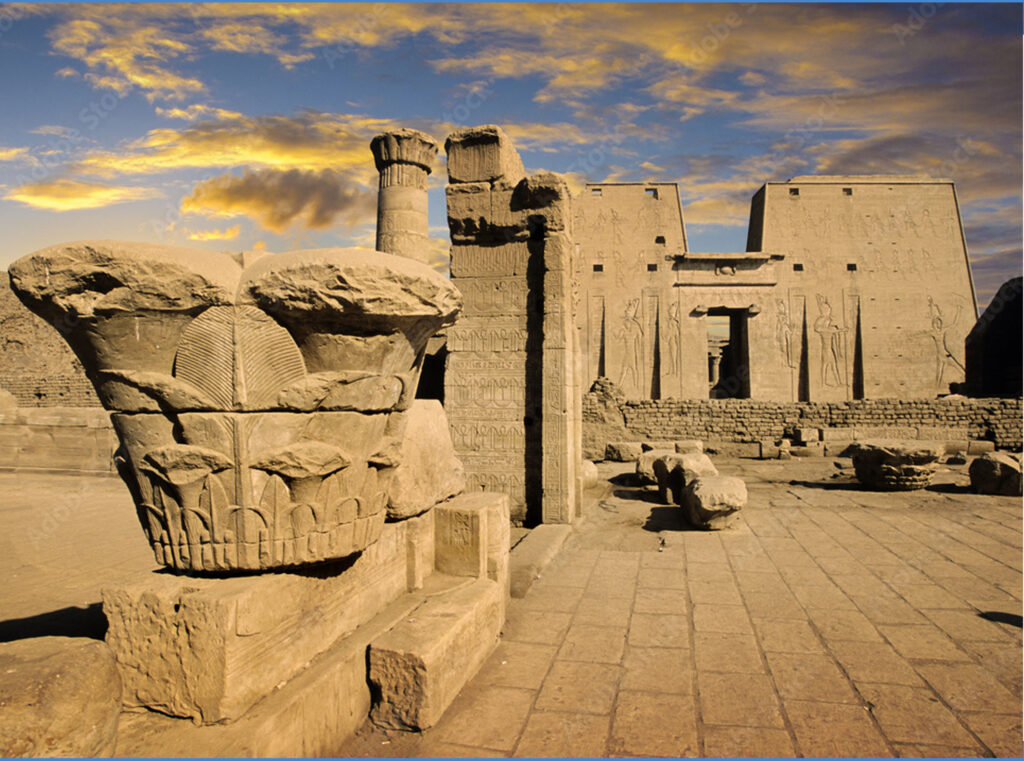
Edfu
Edfu: A Hidden Gem Brought to Life by Luna Travelers
Edfu is a marvel that stands out amidst Egypt’s rich tapestry of ancient history. Nestled between Luxor and Aswan, this small town is home to the magnificent Temple of Edfu, one of the best-preserved temples from ancient times. As I ventured into Edfu, I felt an overwhelming connection to the past, surrounded by structures that have withstood the test of time. This town is not just another stop on the Egyptian map; it’s a portal to a world where gods and pharaohs once walked among men.
Table of Contents:
- The Historical Significance of Edfu
- Exploring the Temple of Edfu: Architecture and Design
- The Mythology Behind Edfu Temple
- Edfu’s Location and How to Get There
- Best Time to Visit Edfu Temple
- What to Expect During Your Visit
- Edfu vs. Other Ancient Egyptian Temples
- Edfu’s Role in Modern Egyptian Tourism
- Preservation Efforts and the Future of Edfu Temple
- Tips for Photographing Edfu Temple
- Nearby Attractions: From Edfu to Aswan
- Accommodation Options in Edfu
- Conclusion: Why Edfu Should Be on Your Egypt Itinerary
The charm of Edfu lies not only in its architectural grandeur but also in its accessibility. Unlike some of Egypt’s more famous sites, Edfu offers a more intimate experience, allowing travelers to fully immerse themselves in history without the overwhelming crowds. It’s a place where ancient stories feel alive, waiting to be discovered. As I walked through its streets, I could almost hear the whispers of history calling out.
Often overlooked in favor of more iconic destinations like the Pyramids of Giza, Edfu is a hidden gem that truly deserves the spotlight. From its rich historical significance to its breathtaking temple, every aspect of this place captivates the imagination. Join me and Luna Travelers as we delve deeper into what makes Edfu a must-visit destination on any Egyptian itinerary.
The Historical Significance of Edfu
Edfu holds a special place in the chronicles of ancient Egypt, dating back to the Ptolemaic period. Once known as “Behdet,” it was a major center for the worship of Horus, the falcon-headed god. Learning about Edfu revealed its crucial role in religious and cultural life. The Temple of Edfu, built between 237 and 57 BCE, may be younger than Karnak or Luxor, but its preservation makes it especially remarkable.
The temple hosted significant religious activities, most notably the annual “Horus Festival,” which drew thousands of worshippers. Walking the temple grounds, I felt a deep reverence for the countless generations that had gathered here in devotion.
Beyond religion, Edfu also served as a political stronghold. The Ptolemies leveraged the temple to align themselves with Horus and legitimize their rule. This intertwining of religion and politics makes Edfu an intriguing study for any history enthusiast.
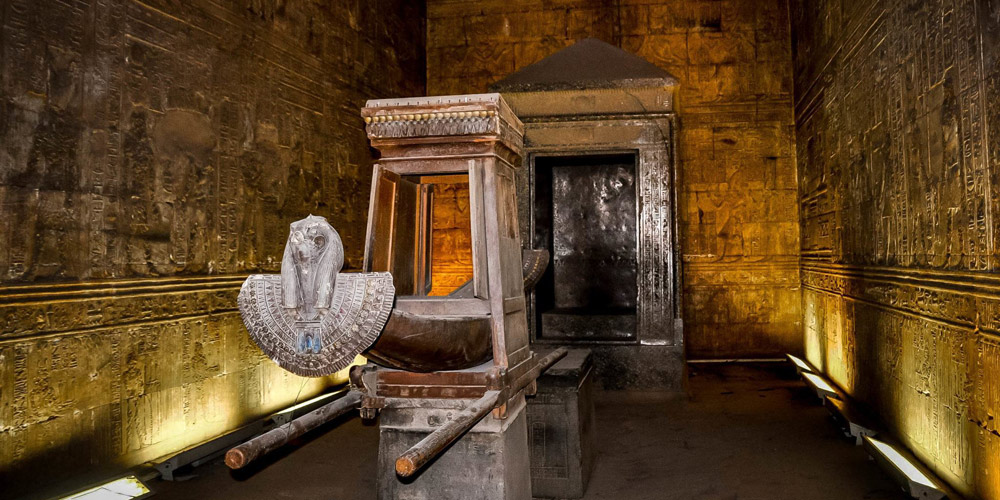
Exploring the Temple of Edfu: Architecture and Design
The Temple of Edfu is a stunning masterpiece of Ptolemaic architecture. As I approached the temple’s entrance, flanked by massive statues of Horus, I was awestruck by its sheer scale—137 meters long and 79 meters wide.
Its outer walls are adorned with rich hieroglyphics and carvings that recount Horus’s epic battles against Seth, the god of chaos.
Inside, the cool corridors and sanctum chambers transported me back in time. The hypostyle hall, with its intricately carved columns, was a highlight. Each detail testified to the extraordinary skill of the artisans who built it. This isn’t just a monument—it’s a tribute to the genius and faith of a civilization that has shaped history.
The Mythology Behind Edfu Temple
The Temple of Edfu is steeped in mythology, primarily honoring Horus, the god of the sky, war, and protection. According to legend, Edfu marks the battlefield where Horus avenged his father Osiris by defeating Seth. The walls vividly depict this myth, capturing tales of divine justice and cosmic order.
As I explored the temple’s reliefs, I was drawn into a world of symbolism and storytelling. The temple also contains inscriptions detailing the rituals performed in Horus’s honor—ceremonies believed to secure prosperity and balance for Egypt. These myths breathe life into the stone, making Edfu a living narrative of ancient belief systems.
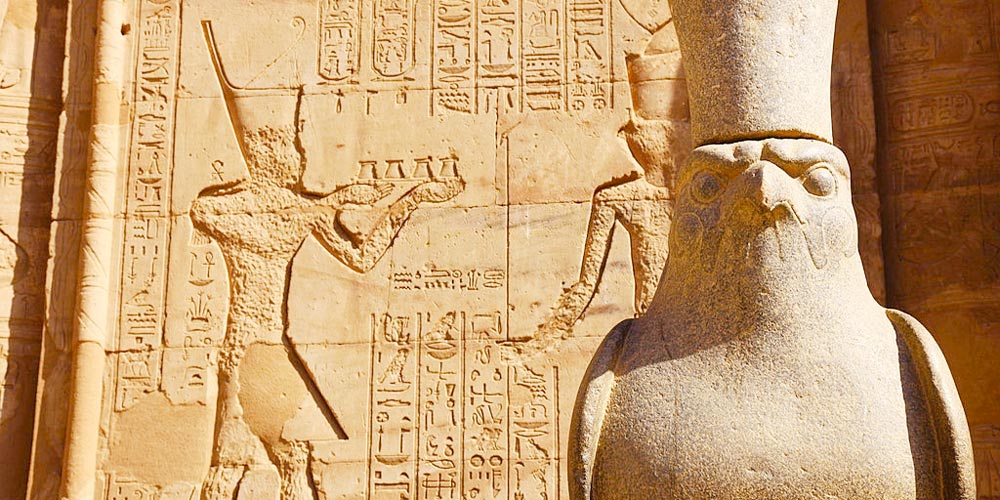
Edfu’s Location and How to Get There
Edfu is perfectly situated along the Nile, roughly midway between Luxor and Aswan, making it a convenient stop for travelers in Upper Egypt. I arrived via a Nile cruise—an enchanting way to reach the town, offering scenic views and a glimpse of traditional riverside life.
If you’re traveling by land, buses and taxis from Luxor or Aswan are readily available. Once in Edfu, the temple is close to the town center, with a charming marketplace at the entrance where local vendors offer handmade goods. The journey to Edfu is every bit rewarding as the destination.
Best Time to Visit Edfu Temple
To get the most out of your visit, plan your trip between October and April. Cooler weather makes walking around the temple much more enjoyable. I found early mornings and late afternoons particularly magical—soft light enhances the carvings and gives the whole site a golden glow.
If you visit during the scorching summer months, try to arrive early to avoid the heat. Wear light clothing, use sunscreen, and stay hydrated. Checking local festival schedules can also elevate your visit—traditional events at the temple add a dynamic layer of modern cultural connection.
What to Expect During Your Visit
The Temple of Edfu is one of the most photogenic and immersive historical sites in Egypt. From towering columns to richly detailed hieroglyphs, every inch of the temple is a visual delight. I recommend using a guide or audio tour to better understand the temple’s symbolic meanings and rituals.
Expect a serene and reflective atmosphere, free from the chaos often found at larger tourist spots. Take your time, and don’t forget your camera—but be respectful of areas where photography may be restricted.
Edfu vs. Other Ancient Egyptian Temples
While temples like Karnak and Luxor showcase Egypt’s grandeur, Edfu provides a more intimate and immersive experience. Its Ptolemaic architecture, blending Egyptian and Hellenistic styles, sets it apart.
What truly distinguishes Edfu is its sole dedication to Horus. This singular focus allows visitors to explore the god’s mythology in rich detail—something that other temples don’t always provide. With fewer crowds and exceptional preservation, Edfu offers a unique perspective on Egypt’s spiritual heritage.
Edfu’s Role in Modern Egyptian Tourism
Thanks to growing global interest, Edfu is now a beloved stop for travelers. As part of Luna Travelers’ curated itineraries, visitors can discover the temple while supporting local communities. I enjoyed browsing handmade souvenirs, knowing that my purchases directly benefited local artisans.
Tourism has boosted infrastructure, yet preservation remains a priority. Conservation efforts are in place to maintain the temple’s integrity, and as travelers, we share the responsibility to respect and protect this cultural treasure.
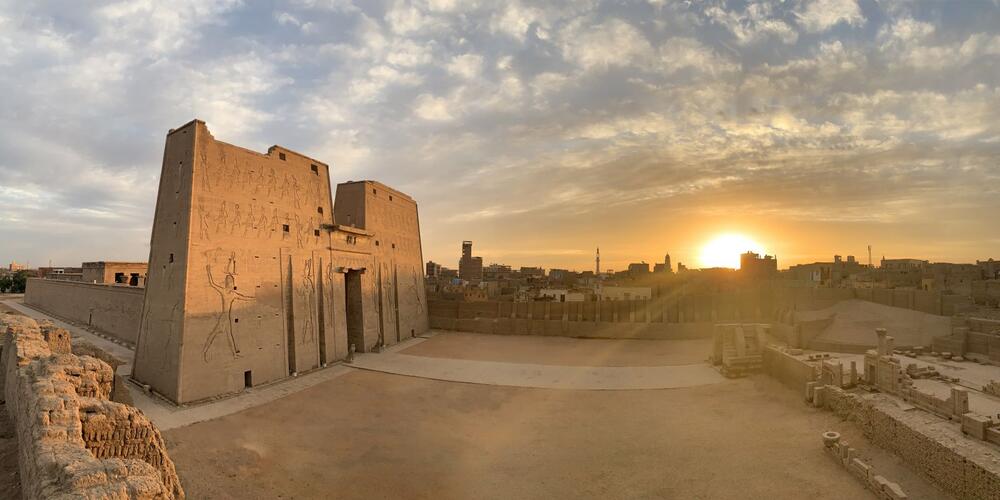
Preservation Efforts and the Future of Edfu Temple
Protecting Edfu for future generations is a collective effort. I was heartened to see conservation teams actively monitoring environmental risks like erosion and pollution.
Educational campaigns help raise awareness about sustainable tourism, ensuring that Edfu’s splendor remains intact for years to come. As awareness and responsible travel increase, the temple’s future looks bright—and Luna Travelers is proud to support initiatives that balance access with preservation.
Tips for Photographing Edfu Temple
Photography at Edfu is incredibly rewarding. Here are a few tips I found helpful:
- Golden Hour: Visit just after sunrise or before sunset for the best light.
- Wide-Angle Lens: Essential for capturing the full scale of the temple.
- Detail Shots: Focus on carvings and hieroglyphics to highlight craftsmanship.
- Respect Others: Be courteous to fellow visitors and follow any restrictions.
- Research in Advance: Know key spots you’d like to shoot ahead of time.
Nearby Attractions: From Edfu to Aswan
Edfu is the perfect launchpad for exploring Upper Egypt. From here, head south to Aswan, home to the stunning Philae Temple and High Dam. I especially enjoyed Kom Ombo Temple, known for its dual dedication to Sobek and Horus—it offers a compelling contrast to Edfu.
For a relaxing escape, take a felucca ride on the Nile and enjoy the scenic beauty and tranquility of the river.
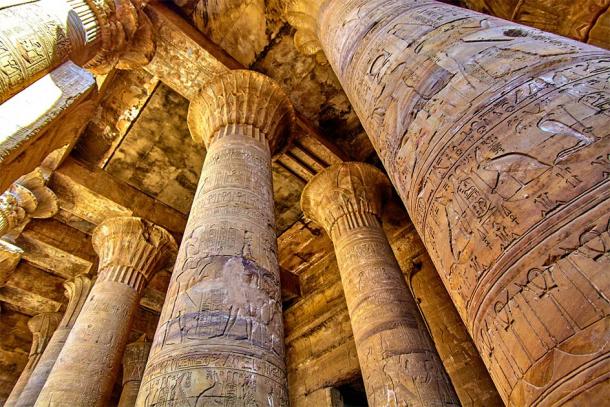
Conclusion: Why Edfu Should Be on Your Egypt Itinerary
Edfu is more than a historical site—it’s a gateway to the soul of ancient Egypt. With its well-preserved temple, rich mythology, and deep cultural roots, Edfu invites you to walk in the footsteps of gods and kings.
Its accessibility, unique charm, and spiritual atmosphere make it a destination not to be missed. So if you’re planning your Egypt adventure, make sure Edfu is on your list.
Explore Edfu and beyond with Luna Travelers—your journey into the heart of ancient Egypt begins here.
